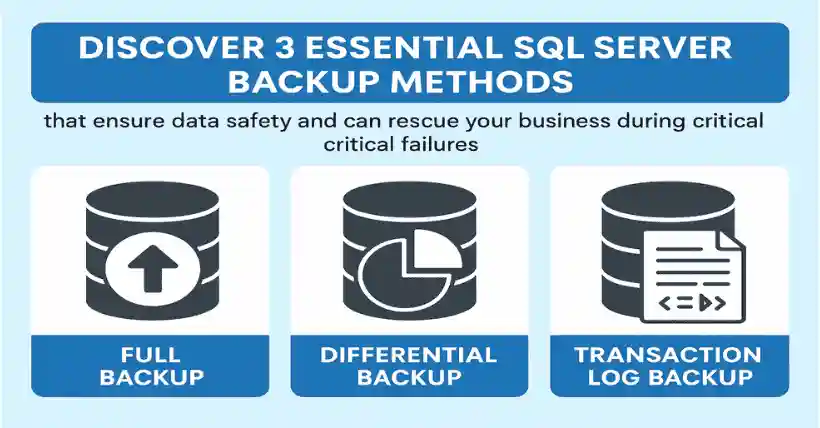The company server suddenly crashed! Six months of order records stored in the database are all gone. Don’t panic! I’ve seen this many times. Today, I’ll teach you step-by-step how to protect your data using SQL Server. Even if you’re a newbie network admin, you can follow along and operate with zero risk.
1. The Easiest Graphical Backup
Open SQL Server Management Studio, right-click the database you want to back up. Choose Tasks ➡ Backup.
Pay attention to the backup type in the popup: choose Full Backup. Beginners are advised to directly check Full Backup.
Don’t select the C drive as the path! It’s best to place it on a separate hard drive or NAS.
2. T-SQL Script for Command Line Users
Experts love this trick. Just use the code:
BACKUP DATABASE [YourDatabaseName]
TO DISK = 'D:backupdata.bak'
WITH FORMAT, NAME = 'Full Backup'This code creates a brand new backup file. Here’s the key point: the WITH FORMAT parameter will overwrite files with the same name. Be cautious with critical data! Restoring the database is even simpler:
RESTORE DATABASE [NewDatabaseName]
FROM DISK = 'D:backupdata.bak'
WITH REPLACE;The WITH REPLACE parameter forces overwrite of the existing database. Triple-check your data before using it!
3. Auto Scheduled Backup Pro Technique
Don’t want to do this manually every day? Set up a Maintenance Plan:
Go to Management Studio → Management → Maintenance Plans → New Plan. Choose the time and backup frequency. Set it to run daily at 3 a.m. and remember to check “Verify backup integrity.”
Key tip: Use date variables in backup filenames, like "DB_$(ESCAPE_SQUOTE(DATE)).bak" so you won’t overwrite old files.
4. Emergency Recovery Manual
When your database is corrupted, first try a tail-log backup:
BACKUP LOG [DatabaseName]
TO DISK = 'D:backuplog.trn'
WITH NORECOVERY;This operation can rescue the most recent data changes. To restore, do it in this order: full backup → differential backup (if any) → log backup.
If you get error code 916, don’t panic—most likely a permissions issue. Right-click the backup file → Properties → Security → Add full control permission for the SQL Server service account.
5. Three Common Traps for Newbies
- Backup files stored on the local disk — if the drive fails, it’s game over.
- Never verifying backups — you’ll only realize the file is corrupted when it’s too late.
- Using the default backup path — if the C drive gets full, it could crash the system.
Proven Effective Strategy:
Weekly full backup + daily differential backup + hourly log backup. Encrypt and compress critical data and upload it to the cloud.
A recent client’s server got water-damaged, but thanks to a cloud backup from three months ago, they fully recovered without losing a single record!
Quick Q&A
Q1: Can the database still be used during backup?
A: Yes, normal usage is not affected, but large databases may slow down during the process.
Q2: How big should the backup file be?
A: Full backups are usually 1/3 to 1/2 the size of the database. If it suddenly grows, check for abnormal data.
Q3: What if I get an “in use” error during restore?
A: Run
ALTER DATABASE [DatabaseName] SET SINGLE_USER WITH ROLLBACK IMMEDIATE
to force disconnect all users.
Final Real-World Case:
An e-commerce company didn’t back up logs. A hard drive failure caused a loss of six hours of order data. Remember, a backup plan isn’t a decoration—it can save your company when disaster strikes. Check your backup strategy now before it’s too late.

Disclaimer:
- This channel does not make any representations or warranties regarding the availability, accuracy, timeliness, effectiveness, or completeness of any information posted. It hereby disclaims any liability or consequences arising from the use of the information.
- This channel is non-commercial and non-profit. The re-posted content does not signify endorsement of its views or responsibility for its authenticity. It does not intend to constitute any other guidance. This channel is not liable for any inaccuracies or errors in the re-posted or published information, directly or indirectly.
- Some data, materials, text, images, etc., used in this channel are sourced from the internet, and all reposts are duly credited to their sources. If you discover any work that infringes on your intellectual property rights or personal legal interests, please contact us, and we will promptly modify or remove it.



